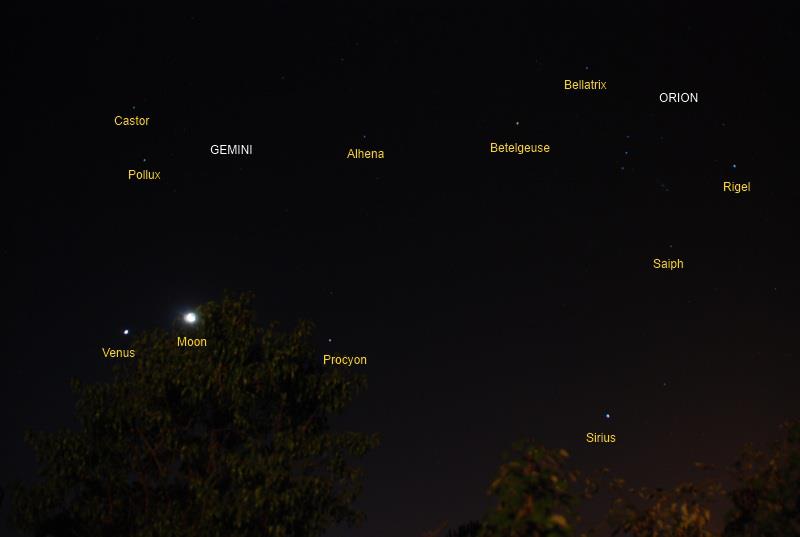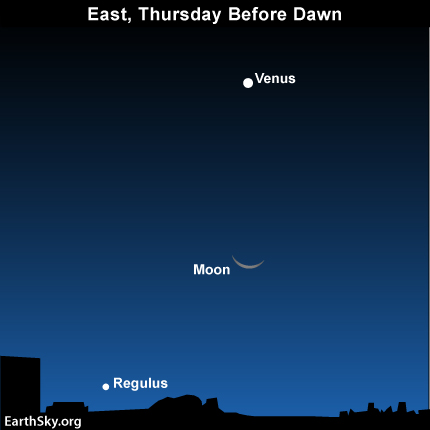Moon and Venus still close in September 13 predawn
sky
The brightest and second-brightest orbs of nighttime – the moon and the planet Venus, respectively – have been glorious in our sky the past few days and still adorn the eastern predawn sky on Thursday, September 13. They are visible throughout the world. Both thewaning crescent moon and Venus will be shining brightly in front of the constellation Cancer the Crab

Here is Wednesday morning’s sky – September 12, 2012 – as seen by EarthSky Facebook friend Annie Lewis in Madrid. Notice the moon next to Venus. By Thursday morning, the moon will be below Venus in the east before dawn. Thanks, Annie! Click here to expand this image.
By Friday, September 14, the moon will pass out of Cancer, but rather close to Regulus, the constellation Leo’s brightest star. Venus, on the other hand, will remain in front of the constellation Cancer until the September 22 equinox.
On or around September 22, Venus will straddle the border of the constellations Cancer andLeo. After that, Venus will continue to move eastward in front of the constellation Leo, finally to meet up with the star Regulus in the predawn hours on October 3. Be sure to circle this date on your calendar. This will be the closest conjunction of a planet and a first-magnitude star for all of 2012.
If you live in the Northern Hemisphere, you should be able to see Regulus near the horizon an hour or so before sunrise. If you live in the Southern Hemisphere, you may miss Regulus altogether because this star still sits low in the glare of morning twilight at southerly latitudes. However, in both the Northern and Southern Hemispheres, Regulus rises about four minutes earlier with each passing day. So by October 3, the Venus/Regulus conjunction should be visible in the predawn sky from all around the world.

And don’t forget the planets in the evening sky! Saturn and Mars can still be seen low in the west after sunset. Here’s an image from EarthSky Facebook friend Duke Marsh in New Albany, Indiana. It’s looking west on Tuesday evening, September 11, 2012, at around 9 p.m. Thanks, Duke! Click here to expand this image.
Bottom line: Enjoy the predawn sky in the first week of September 2012, as the waning crescent moon passes the dazzling planet Venus in the east. Look east in the hours before sunrise
e
A Story of Astronomical Importance
This is an incredible time to be an astronomer. Actually, it’s an incredible time for anybodywho is interested in our place in the universe. The last few decades have seen the advent of technologies that have allowed us to see further into space than ever before.
One of the advantages of looking further away is that in astronomy, this also means looking further back in time. Light travels extremely quickly from point to point, but the distances between celestial objects are so vast that the time their light takes to reach us is significant. Start close to home, with the Sun, for example. Its light takes eight minutes to reach us here on Earth. Spacecraft operating in the distant reaches of the outer solar system – like NASA’s Cassini probe, currently exploring Saturn and its amazing family of moons – must be autonomous, because signals from Earth can take more than an hour to reach them. The nearest star is four light years away, and so we see it as it was in 2003. The center of the Milky Way is 25,000 light years away, and the nearest large galaxy, Andromeda, is 2.2 million light years away, and this immense distance takes us no further than our local neighbourhood.
Looking back in time in this way, we see a universe that looks different from the one around us. Galaxies, for example, tend to look smaller than they are now, because when the light we see left them, they were still in the process of assembling. Star formation was more rapid back then; the universe of today is, perhaps depressingly, past its peak, and the rate at which new stars are being born is declining. This evolving universe provides the most straightforward evidence that there really is a cosmic story, with a beginning many billions of years ago.
In fact, analysis of this early universe, together with a lot of work and many other observations besides, has allowed us to conclude that our universe began in an almost unimaginably hot, dense state some 13.7 billion years ago. The sophistication of modern cosmological measurements can be breathtaking; we know the age of the universe more accurately than we know the age of the Earth. We also know what the major constituents of the universe are, but this raises more questions. Ordinary matter, made of atoms of carbon, oxygen, nitrogen and all the rest, turns out to account for only a sixth of the mass in the universe, the rest being a mysterious substance which we call ”dark matter.” The expansion of the universe is not, as once was expected, slowing down under the pull of gravity, but rather accelerating under the influence of an antigravity force that remained undetected until just 10 years ago.
We have made progress in other areas too. The search for life beyond our own planet, and beyond our own solar system, is something that has inspired scientists, artists and authors for centuries. There is still no sign of little green men, bug-eyed monsters or bacteria on Mars, but we are getting somewhere. The detection of planets beyond our solar system is now routine; more than 200 of these extra-solar planets, or exoplanets, are now known. All are large – probably because large planets are easy to detect – but it would not be surprising if the first Earth-sized worlds known to orbit another star were detected in the next year or two. The first measurement of the composition of the atmosphere of two of these planets was announced just a few weeks ago, and the pace of discovery is rapid.
With so much going on – we haven’t mentioned the exploration of Mars, or the grandstand view we have of merging galaxies and much, much else – it is difficult to know where to look next. In this column, we hope to show you around our universe. After all, the story belongs to all of us, insignificant though our place in it must be.



